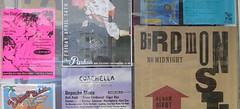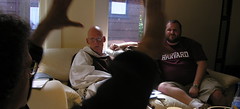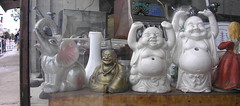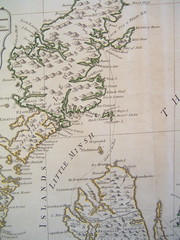Venturesome
 I was in Thailand with a theory-loving sociologist who wanted a chance to let her mind float away from its mores into the spiritual. She made me read the Celestine Prophecy on the beach and she had her Osho tarot deck with her. We were each drawing a card a day, each morning, more as a meditation technique than a fortune-telling device. I kept drawing cards like 'completion,' 'maturity,' and 'morality,' feeling rather pleased with myself (Danah was drawing 'anxiety,' 'fighting'). Then one morning on Koh Phanong I drew the "Adventure" card and one hour later swam straight into a jellyfish. I was rushed to the hospital by motorboat, motorcycle, speedboat, and ambulanance, doused with morphine for the burns and shock, and spent two days in bedrest, half of my face swollen shut.
I was in Thailand with a theory-loving sociologist who wanted a chance to let her mind float away from its mores into the spiritual. She made me read the Celestine Prophecy on the beach and she had her Osho tarot deck with her. We were each drawing a card a day, each morning, more as a meditation technique than a fortune-telling device. I kept drawing cards like 'completion,' 'maturity,' and 'morality,' feeling rather pleased with myself (Danah was drawing 'anxiety,' 'fighting'). Then one morning on Koh Phanong I drew the "Adventure" card and one hour later swam straight into a jellyfish. I was rushed to the hospital by motorboat, motorcycle, speedboat, and ambulanance, doused with morphine for the burns and shock, and spent two days in bedrest, half of my face swollen shut. When I was going up on morphine after the jellyfish, Danah asked me how I felt. I told her that I had gone out of my body and was sitting on the other side of the boat, where I was so surprised to be able to see myself from the outside that I looked for a camera and imagined taking my own picture so as to remember.
I'm going to paste here a few paragraphs of mad speculation from a letter I wrote soon after to a friend interested in visual culture as a historian, with whom I've previously had many fairly useless conversations about drug culture, spirituality, art, and vision in the contemporary world: useless because I'm not the person to talk to. Visits to the hospital aside, I don't spend time with new-age reading material, and I've never tried drugs.
The visual culture I study is grounded in the built environment on the one hand or previous centuries' spiritualism on the other. But one major question among many people who study contemporary visual culture is how we came to have such a visually intense culture without a way to talk about it: why visual studies departments failed across the country in the 80s and 90s, leaving art history as the only discipline with tools to talk about how people today think about the world around them. Media studies may change that trend, but the historical track is worth noting. In Thailand I necessarily spent a few days thinking about drugs, visual fantasies, and contemporary culture, while my mind floated away on the stream of jellyfish-induced hallucinations.
One friend with whom I was travelling is an apostle of drugs convicted of their ability to unlock different experiences of time and visuality that are accessible to the human mind but usually repressed. So after the morphine experience she spoke to me enthusiastically about her experiences with other chemicals that stimulated similar out-of-body travel. She then began to talk about trance music -- the repetitive throbbing techno music I've hated since it got big my junior year, apologizing to my friends for being so square all along. She described trance as being designed to stimulate a flashback to out-of-body experiences among people wh ohad used acid. Such that she and friends could enter the same mental state as when they had taken the drugs, without the drugs themselves, when listening to the music.
I was especially struck by this articulation of what I always sensed as the eerie exclusiveness of rave culture: that if you don't get it, they have no use for you. And now I wonder if that exclusiveness can be tacked down to a series of cultural assumptions among ravers that would be interesting to review, as follows: 1) humans are spiritual creatures whose nature is to meditate, to expand and contract time, to visualize their spiritual experiences (including visualizing oneself from without in sympathy with other points of view); 2) modern humans can access powerful creative and shared visions (which are part shared fantasy and part spiritual reality) only through drugs, therefore 3) anyone in modern culture who doesn't do drugs doesn't have access to authentic spiritual activity.
This attitude makes much sense of the automatic hostility towards religion one encounters among the same set; the axiomatic dismissal of Christianity as 'mere ritual', a phrase at which I always catching myself laughing: for the anthropologist, everything worth thinking or doing in human history has been structured as ritual, and nothing could be more noble than ackowledging and repeating a continuous tradition of ritual latent in one's culture that still holds the power to transform.
So I wonder about those of us who never did drugs: whether indeed it was really about respect for one's body and one's elders, as the Nancy Reagan literature preached, or because those people had already accomplished access to a spiritual dimension: if they already paid attention to their dreams, wondered about ghosts, and had experiences in church. And so thought of the spiritual world as accessible to them.
For then we'd start thinking about drug experimenters as not inherently disrespectful of their bodies, but radically skeptical about the versions of spiritual traditions that they had inherited. After all, don't we think about those early adopters of drugs as the physicists, the refugee Jewish intellectual, the Marxists -- the very groups most likely to have embraced advanced 19th-century despair towards any return to shared spirituality? I mean that for the existentialist, the only things that can be shared are the material and media forms that Marshall McLuhan called man's external extensions of himself, and of these the aesthetic extensions like clothing or ritual were only too tragically liable to populist political manipulation. But fugitive, illegal, pseudo-scientific expeditions into the unconscious with drugs: these would be shared, and kept private (sacred) from political manipulation by their very irrationality. And if the adventuresome tried on chemicals together and recognized patters in the way individuals experienced time or vision -- from the very basic differences of acceleration and deceleration by different substances to perhaps more significant-seeming patterns of shared visual archetypes in Jungian form -- then surely there seemed to be no limit to how much of the sacred world could be shared if mankind were all to use drugs.
The success of this fantasy among people otherwise so committed to the pluralistic, rational, political sphere of the Enlightenment would depend on setting up drug visions as a special, sacred category in between the political and fully shared (therefore manipulative) and the personal, phenomenal, totally irational unconscious (therefore politically inconsequential). So drugs would be set up as a sphere of limited sharing of fantasies and perception with immense political and personal power: a sphere of art without the politics of aesthetics that threatens to degrade canvases into commodities and propaganda: a sphere of tribal community without national socialism: a sphere appropriate to a spiritual elite bound together by the evanescence, danger, and biological science of the experiment.
I am trying to point to the instability of this construct. Drugs were set up as the key to a political and spiritual Shangrai-la in the 1950s and 60s, a moment when all intellectual history and critical theory seemed to point to despair before mass culture, where no good impulse of charity could bear fruit, where creativity threatened to be outdated, where the future of political individuality was mocked by a dozen Orwells and Huxleys. For any construct to offer a solution in such a climate of despair was marvelous: for drugs to do it depended mainly on modern man's lack of experience with the visual/spiritual frontier on the one hand, and with neurochemistry on the other. Drugs were staged as the golden arrow of politics for the next political generation.
Were drugs legalized, their appeal for this group would surely vanish. For they would be forced to acknowledge all their visions as common as the willingness to enter a shared ritual, all their precious colelctive energy as of the same substance that binds together churches and poets and lovers and conspiracy theorists and theater-goers and consumers of advertising, who with more or less engagement, experience, self-control, or suspcicion share their absorption in the shared visual experience.
The poet, the would-be psychic, the student of English literature who tries to read every other individual without the aid of drugs, is very much in the camp of the romantic liberal -- a misunderstood category in this day of war between romantics and liberals. The romantic liberal (before the tribes split, mid-19th-century) believed in the principle of freedom, not so much the freedom to do anything as the freedom to feel anything.
This freedom is everywhere in peril not so much because of traditional politics or protectionist market strictures as in the fact that man never knows the extent to which he is capable of feeling ifferently. Man is cursed by his own lack of imagination as much as by that of his peers.
The only conceivable solution is a culture awakening of heightened consciousness -- a collecture cultural therapy that can have no end. So this is the French Revolution in Shelley's eyes or the Italian one in Trevelyan's. Both writers hallucinated out of history a human impulse towards immense compassion that had little innately related to the principles of the particular historical revolution in question.
Learning from history would be a matter of not falling back on the Enlightenment or the 1960s to save us. No golden arrow exists: not drugs, not the tearing down of traditional rituals, not their dogmatic protection, not the free market of world religions. Learning from history might be a question of learning to value romantic liberalism -- the freedom to feel anything -- and to apply it as one encounters the future, the past, tradition, and innovation alike. One can feel anything, from isolation to projected unity of spirit, to even -- with application, the thoughts and emotions of another human being. Each of these sentiments has a corresponding visual culture. So if one can take up any of them, which should one take given the politics of the moment? One can feel anything: and one is left then bewilderingly alone with the question, how can one best accomplish right action and sustain right feeling towards the rest of the world? Which visual forms will help us to organize that right now?










0 Comments:
Post a Comment
<< Home